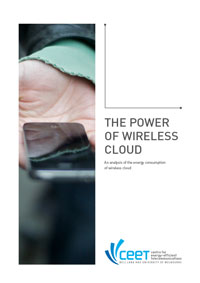| Apr 11, 2013 | |
Massive energy cost hidden in wireless cloud boom |
|
| (Nanowerk News) Insatiable demand for popular online applications on the go has created a sustainability time bomb for cloud services, according to Australian research published this week. | |
| For the first time, researchers have calculated the energy consumption of the multiple components needed to support cloud services accessed via wireless networks. | |
 The report "The Power of Wireless Cloud" warns that industry has vastly underestimated energy consumption across the cloud ecosystem as more people access services using portable devices. The popularity of services like Google Apps, Office 365, Amazon Web Services (AWS), Facebook, Zoho cloud office suite, and many others delivered over wireless networks, is driving a massive surge in energy consumption. The energy use of cloud services accessed via wireless networks is expected to grow up to 460% between 2012 and 2015, the equivalent of 4.9 million new cars on the roads. The analysis shows that wireless access networks (WiFi and 4G LTE) will be responsible for 90% of that energy. Data centres, the focus of recent high-profile Greenpeace research, account for only 9%. The new white paper, by Melbourne’s Centre for Energy Efficient Telecommunications (CEET) shows that urgent action is required to curb spiraling energy consumption and CO2 emissions. Principal Research Fellow Dr Kerry Hinton, CEET Deputy Director stated, “When Greenpeace analysed cloud efficiency it hit a nerve with the likes of Google, Microsoft and Apple by suggesting that data centres are to blame for a ‘dirty cloud’. In fact, the problem is much worse, data centres aren’t the biggest issue. The trend towards wireless is the real problem, and the networks are to blame. By 2015, the energy consumption of data centres will be a drop in the ocean compared to wireless networks in delivering cloud services.” |
|
| “The problem is that we’re all accessing cloud services – things like webmail, social networking and virtual applications – over wireless networks. It’s the modern way but wireless is an energy monster, it’s just inherently inefficient.” | |
| “Our calculations show that, in 2015, the wireless networks we use to access cloud services will command around 90% of the energy needed to power the entire wireless cloud services ecosystem. By comparison, data centres will account for only 9% or less. Industry needs to focus on the real issues with wireless network technologies if it wants to solve this problem.” | |
| CEET is investigating ways to improve the way networks are managed for energy efficiency. The global telecommunications system is estimated to consume 2% of the world’s energy, and that figure could grow to 10% by 2020 if no action is taken. | |
| “We often think of bandwidth as the barrier to the way online services evolve and improve. The very real message here is that the real bottleneck, looming sooner than we think, may be energy.” | |
| “The findings of this paper are an important starting point to improving the energy efficiency of cloud services. They provide a benchmark, highlighting where attention is needed and to measure progress to improvement.” | |
| “I think its unlikely people trade away the mobile convenience of these services. Another solution might be to increase the way network resources are shared among users, but more likely we’ll need a radical improvement in the efficiency of the technologies themselves and potentially a fundamental change to the way data is managed across the global network. These are the things we’re investigating at CEET. |
| Source: University of Melbourne |
